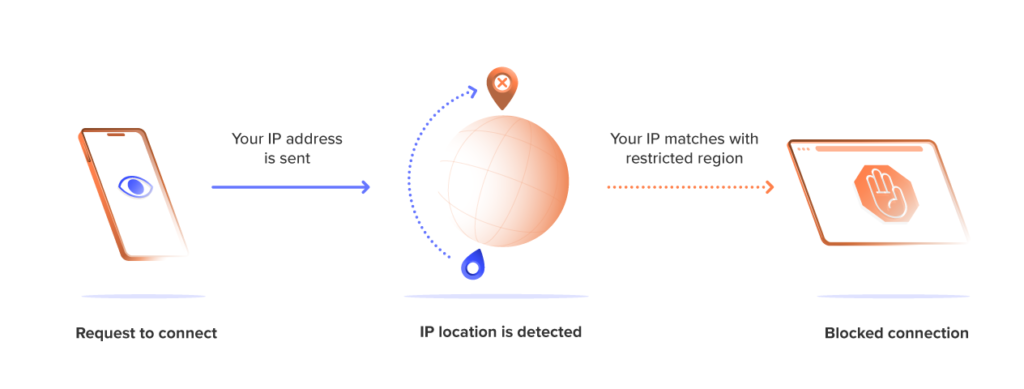
Geo-blocking restricts access to online content based on your IP address and location. You can bypass these barriers with a Virtual Private Network (VPN), which masks your real location and makes it appear you’re browsing from another country.
Let’s say you’re sitting in your hotel room after a long international flight. The Wi-Fi connects perfectly. You open Netflix to continue that series you’ve been watching. Suddenly, an error message appears: “This content is not available in your region.”
Welcome to the frustrating world of geo-blocking — where IP addresses decide what you can and cannot watch online. But you don’t have to accept these restrictions. Whether you’re a digital nomad, remote worker, or just someone who believes information should be free, there are ways to bypass internet barriers.
What is geo-blocking?
Geo-blocking means restricting access to content based on your location, using IP addresses and other tracking methods to determine where you’re online and blocking you accordingly.
This security process restricts your right to information using internet geolocation techniques, such as checking your IP address against a blacklist or whitelist, GPS queries, and estimating your physical location (Wikipedia, 2024).
Think of it as a digital checkpoint on the information highway. But instead of checking your ID for age verification, this checkpoint examines your location.
If you’re trying to watch the BBC iPlayer from New York, Disney+ from Mumbai, or stream the Super Bowl from London, you’ll hit an invisible wall. The system compares your IP address against its database and makes a split-second decision: grant access or show an error message.
Geo-blocking: Myth vs reality
Myth: Geo-blocking only affects entertainment content.
Reality: Geo-blocking is used in a variety of sectors, including streaming services, online gaming, e-commerce, censorship, and software apps (Digital Research, 2025). From online shopping to business software, geo-restrictions impact far more than just your Netflix catalog.
The technology affects millions of users daily. Approximately 23-25% of internet users worldwide use VPNs (Industry Analysis, 2024), with geo-blocking being one of the primary drivers.
In the United States alone, 46% of adults currently use VPN technology (Privacy Research Institute, 2024), reflecting significant awareness of these digital barriers.
How does geo-blocking work?
Geo-blocking works by detecting your IP address, which reveals your real location, then compares it against allowed regions and blocks you if you’re in a restricted area.
When you connect to any website or app, your device sends a request that includes your IP address — essentially your location marker. When you open a site, those enforcing a geo-blocking policy will use tools to detect your public IP address (which represents your location).
If your IP address matches a region that is barred from accessing that content or platform, the tool will automatically block your connection (Digital Security Report, 2025).
But IP addresses aren’t the only detection method. Modern geo-blocking systems employ multiple layers of verification:
- IP address geolocation databases that map billions of addresses to physical locations
- GPS data from mobile devices for precise location tracking
- Network latency measurements to estimate distance from servers
- Payment method verification checking billing addresses and credit card origins
- Device language and time zone settings for additional confirmation
- Browser fingerprinting to identify unique device characteristics
Myth: Simply changing your device’s time zone can bypass geo-blocks.
Reality: This multi-layered approach makes simple workarounds ineffective. You can’t just change your device’s time zone anymore and expect to fool Netflix or access the Champions League final stream.

How to bypass geo-restrictions
You can bypass geo-restrictions using various methods, with VPNs being the most effective, followed by Smart DNS, proxy servers, and other techniques that mask your location.
The good news? While geo-blocking technology has become more sophisticated, so have the methods to bypass it. You have multiple options, each with its own strengths and ideal use cases.
The key is choosing the right tool for your business needs.
Can a VPN help bypass geo-restrictions?
VPNs like FastVPN are highly effective at bypassing geo-restrictions by hiding your IP address and routing your connection through servers in different countries, making it appear as if you’re browsing from that location.
When IP address-based blocking is employed, VPN services can be used to evade them. You can access a website using a United States IP address in order to browse content that’s not available in your country (Wikipedia, 2024).
Netflix, Amazon Prime, and BBC iPlayer are among the most popular streaming platforms accessed through VPN apps.
Bypass geo-restrictions with VPN
Using a VPN is the best option for bypassing geo-restrictions. A trustworthy and secure VPN service can guarantee your data security, a stable connection, and is easy to use. Unlike other methods, VPNs provide strong protection while maintaining fast speeds
Myth: Free VPN services work just as well as paid ones for bypassing geo-blocks.
Reality: Free services often lack the infrastructure and technology needed to consistently bypass geo-blocks.
According to cybersecurity research, free options frequently sell user data, have limited server networks, and are easily detected by streaming platforms (Security Analysis Group, 2025).
Here’s how to bypass geo-restrictions with FastVPN
- Sign up for FastVPN – Visit fastvpn.com and choose a subscription plan
- Download the FastVPN app – Available for Windows, Mac, iOS, Android, and more
- Install and launch the application – Follow the simple setup wizard
- Log in with your credentials – Use the account you just created
- Choose a server location – Select from 100+ countries worldwide
- Click connect – FastVPN will establish a secure connection in seconds
- Access geo-blocked content – Navigate to your desired website or app and enjoy unrestricted access
FastVPN’s bank-grade encryption ensures your data remains secure, and with 2700+ servers optimized for streaming, you’ll experience minimal speed loss while watching video content.
How to remove geo-blocking without a VPN
You can remove geo-blocking without a VPN using methods like Smart DNS, Tor Browser, proxy servers, and other techniques, though these generally offer less security and reliability than VPN apps.
While VPNs offer the most comprehensive solution, several alternative methods can help you bypass geo-restrictions:
Method 1. Use Smart DNS
Smart DNS services work by rerouting only your DNS queries through servers in different locations. Unlike VPNs, Smart DNS doesn’t encrypt your entire connection, allowing for faster speeds.
- Maintains full internet speed
- Works on devices that don’t support VPNs
- No encryption or privacy protection
- Doesn’t bypass IP-based blocks
Method 2. Open with Tor browser
The Tor network routes your traffic through multiple volunteer-operated servers worldwide. By routing your internet traffic through multiple servers before reaching its destination, Tor obscures your IP address and makes it difficult for websites to track your location (Wikipedia, 2024).
- High level of anonymity
- Free to use
- Significantly slower speeds
- Not suitable for streaming
Method 3. Use a proxy server
Proxy servers act as intermediaries between you and the website you’re trying to access, forwarding your requests from their location.
- Simple to set up
- Often free
- Limited security
- Frequently detected and blocked
Method 4. VPS as a personal proxy
Set up a proxy server on a cloud VPS in another region.
- Full control, and less likely to be blocked
- Requires technical setup and hosting cost
Method 5. Cloudflare tunnel
Tunnel traffic through Cloudflare’s edge network to reach remote servers.
- Bypasses local restrictions, encrypted
- Complex setup, use-case specific
Method 6. DNS-over-HTTPS (DoH) / DNS-over-TLS (DoT)
Encrypt DNS queries with services like Cloudflare (1.1.1.1) or Google (8.8.8.8).
- Bypasses DNS-level restrictions
- Doesn’t bypass IP-based blocks
Method 7. Region/language settings
Change account or browser region (e.g., YouTube, Google).
- Quick workaround on some platforms
- Not effective on IP-restricted services
Method 8. Mobile network tethering
Switch from Wi-Fi to mobile data to bypass local blocks.
- Can work in restricted environments
- Not ideal for consistent access
Please note: Most of these options don’t provide the same level of privacy, security, or reliability as a VPN. For complete protection and stable access, a trusted VPN remains the best all-in-one solution.
Myth: Country-level IP blocking provides sufficient security protection.
Reality: IP address data alone won’t protect networks effectively. Security experts note that it’s usually trivial for an attacker to work around geo-blocks by obtaining IP addresses within specific countries (Cybersecurity Research Foundation, 2024). While geo-blocking can reduce noise from untargeted attacks, it doesn’t significantly increase security against determined threats.
Conclusion
The internet was designed to be borderless, but geo-blocking creates barriers that limit your access to information. Whether you’re traveling for business, living abroad, or want to manage your subscription accounts, understanding how to bypass geo-restrictions gives you more control.
While there are many methods to overcome these digital borders, a reliable VPN like FastVPN offers a comprehensive solution — combining security, speed, and simplicity in one package. Don’t let your location dictate what you can access online. Take control of your internet freedom today.
FAQ
What is geo-restricted content?
Geo-restricted content is online material — videos, websites, apps, or services — that’s only accessible from specific geographical locations due to licensing agreements, legal restrictions, or business strategies.
Streaming services like Netflix or Hulu acquire licenses for specific regions (FlashRouters, 2024).
For instance, 58% of Netflix subscribers report encountering geo-blocked content, while platforms like Hulu operate only in the US and Japan (Streaming Analytics, 2024). This includes streaming services with different catalogs per country, sports broadcasts limited to certain regions, and websites blocked by governments or organizations.
Is bypassing geo-blocking illegal?
Bypassing geo-blocking is not illegal in most countries, but it may violate the terms of service of the platform you’re accessing, which could result in account suspension.
The legality of circumventing geo-blocking to watch foreign video services under local copyright laws is unclear and varies by country (Wikipedia, 2024). While using a VPN is legal in most countries, accessing geo-blocked content might breach platform agreements.
It’s not illegal, but it’s technically against company rules — in theory, they could terminate your account if they catch you circumventing their rules, but they probably won’t since you’re a paying customer (All Things Secured, 2025).
Does VPN prevent location tracking?
VPNs prevent most forms of location tracking by masking your real IP address and encrypting your internet connection. However, they don’t block all tracking methods — GPS on mobile devices, browser fingerprinting, and logged-in accounts can still reveal location information. For comprehensive privacy, combine VPN use with other privacy practices.
What does geo access mean?
Geo access refers to the ability to access online content or services based on your geographical location. It encompasses both the restrictions placed on content (geo-blocking) and the permissions granted to users in specific regions. When a service offers “geo access,” it means the content is available in your current location.
What is geo tracking?
Geo tracking is the process of determining and monitoring the geographical location of a device or user through IP address detection, GPS, and Wi-Fi positioning. By tracking your IP address, websites can determine your location using online databases that provide IP-to-location data (InstaSafe, 2025).





